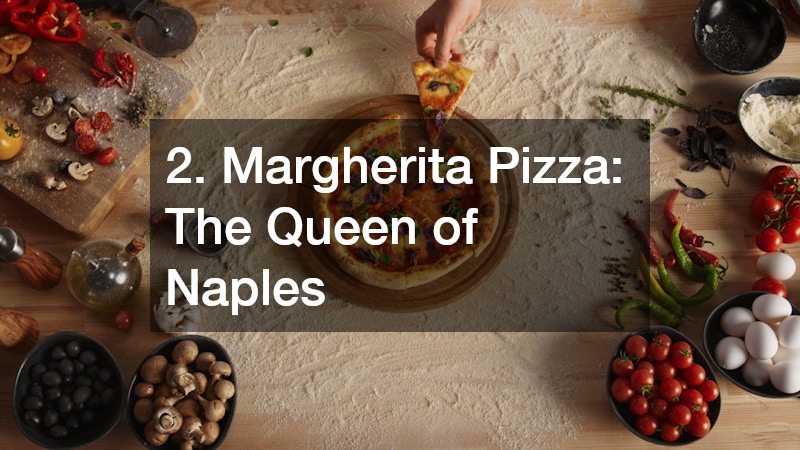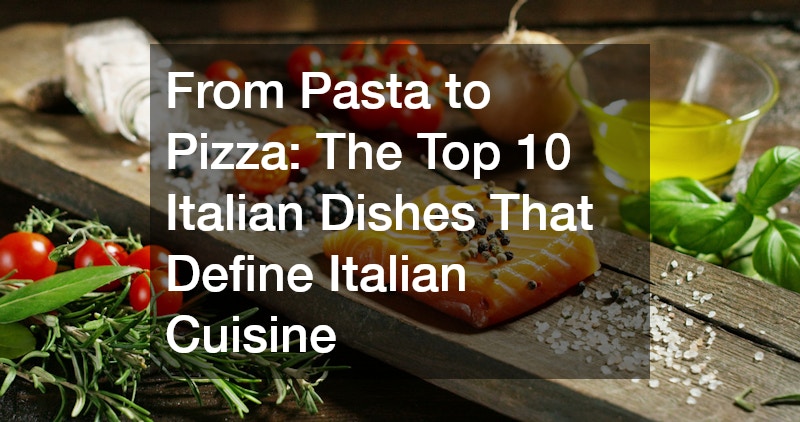
Italian cuisine is one of the most beloved and influential in the world. From rustic trattorias in Tuscany to upscale restaurants in New York, the flavors of Italy have crossed borders and touched millions of palates. But what exactly makes Italian food so iconic? What are the must-try dishes that truly represent its soul?
In this article, we’ll explore the top 10 Italian dishes that define Italian cuisine, each chosen for its cultural significance, flavor profile, and worldwide popularity. Perfect for foodies looking to discover—or revisit—the heart of Italian cooking, this guide is more than a menu; it’s a journey into the rich history and simplicity that make Italian dishes unforgettable.
What Makes Italian Cuisine So Unique?
Before diving into the list, it’s essential to understand what sets Italian food apart. At the core of every Italian dish is a respect for ingredients. Simplicity rules, but it’s never boring. Italian chefs often use only a handful of ingredients in a recipe, but those ingredients are of the highest quality—think vine-ripened tomatoes, freshly pressed olive oil, hand-made pasta, and fragrant herbs.
Italian food also embraces regional diversity. Northern Italy loves its creamy risottos and butter-based sauces, while the South leans into bold tomato flavors and spicy sausage. This balance between tradition, variety, and quality is what makes Italian food both comforting and exciting.
1. Spaghetti alla Carbonara: A Roman Classic
This creamy, peppery pasta dish hails from Rome and is beloved across the globe. Made with just five ingredients—eggs, Pecorino Romano, guanciale (cured pork cheek), black pepper, and pasta—Carbonara is a prime example of the Italian commitment to simplicity and flavor.
Why It Defines Italian Cuisine:
- Minimalist yet rich in taste
- Relies on technique rather than heavy cream or additives
- Celebrates traditional Roman ingredients
Foodie Tip:
Authentic carbonara does not use cream—it’s the egg and cheese mixture that gives it that silky texture.
2. Margherita Pizza: The Queen of Naples

No list of Italian dishes is complete without pizza, and the Pizza Margherita reigns supreme. This Neapolitan staple features a thin, charred crust, fresh mozzarella, basil, and tomatoes—colors that mirror the Italian flag.
Why It Defines Italian Cuisine:
- Invented in Naples to honor Queen Margherita of Savoy
- Highlights the importance of balance and quality ingredients
- Represents Italy’s global food legacy
Foodie Tip:
Look for DOP-certified ingredients (like San Marzano tomatoes and buffalo mozzarella) for the most authentic taste.
3. Lasagna al Forno: Layers of Comfort
Lasagna isn’t just comfort food; it’s a symbol of celebration in many Italian households. Traditionally made with layers of fresh pasta, slow-cooked Bolognese sauce, béchamel, and Parmigiano-Reggiano, this dish is hearty and full of love.
Why It Defines Italian Cuisine:
- Emphasizes time-honored cooking methods
- Regional variations (such as Neapolitan or vegetarian) showcase Italy’s culinary diversity
- A crowd-pleaser that reflects Italian family values
Foodie Tip:
For an authentic experience, try Lasagna alla Bolognese, which uses béchamel sauce instead of ricotta.
4. Risotto alla Milanese: Creamy, Golden Perfection
Originating in Northern Italy, particularly Milan, this golden-hued rice dish is flavored with saffron, giving it both color and a subtle, earthy taste. Unlike boiled rice, risotto is cooked slowly by adding broth in increments, creating a creamy consistency.
Why It Defines Italian Cuisine:
- Highlights the rice-growing regions of Northern Italy
- Focuses on texture and slow-cooking precision
- Celebrates saffron, a prized (and expensive) spice
Foodie Tip:
Stir constantly and use Arborio or Carnaroli rice for the perfect creamy texture.
5. Osso Buco: Braised Elegance on a Plate
Another Milanese specialty, Osso Buco (braised veal shanks) is slow-cooked in white wine, broth, vegetables, and herbs until the meat is fork-tender. It’s often served with risotto or polenta.
Why It Defines Italian Cuisine:
- Showcases mastery in braising and slow cooking
- Combines humble cuts with sophisticated technique
- Rooted in rustic tradition yet elevated in flavor
Foodie Tip:
Don’t skip the gremolata—a mix of parsley, lemon zest, and garlic added before serving to brighten up the dish.
6. Tagliatelle al Ragù (Bolognese): A Pasta Lover’s Dream
While many associate “Bolognese” with spaghetti, the authentic version from Bologna is served with tagliatelle, a broader, flatter pasta that holds the sauce beautifully. The ragù is a meat-based sauce made with beef, pork, tomato, wine, and aromatic vegetables, slow-cooked for hours.
Why It Defines Italian Cuisine:
- Demonstrates regional pride and cooking patience
- Pairs specific sauces with specific pasta shapes
- Focuses on the depth of flavor through slow preparation
Foodie Tip:
Avoid canned Bolognese—homemade ragù is the key to this dish’s full-bodied flavor.
7. Eggplant Parmigiana: Southern Italy’s Veggie Star
Layers of fried eggplant, rich tomato sauce, basil, mozzarella, and grated cheese are baked to bubbly perfection in Melanzane alla Parmigiana. It’s a vegetarian dish with depth and satisfaction.
Why It Defines Italian Cuisine:
- Exemplifies cucina povera (peasant-style cooking)
- Transforms simple vegetables into a decadent meal
- Popular throughout Southern Italy, especially Campania and Sicily
Foodie Tip:
Use firm, young eggplants and salt them before cooking to reduce bitterness.
8. Tiramisu: Italy’s Irresistible Dessert

No Italian meal is complete without dessert, and Tiramisu is the ultimate pick-me-up (its name literally means “cheer me up”). Made with layers of espresso-soaked ladyfingers, mascarpone cream, and cocoa, it’s elegant yet easy to love.
Why It Defines Italian Cuisine:
- Combines coffee, dairy, and texture in perfect balance
- Represents the Italian love for simple, no-bake desserts
- Universally popular, both in restaurants and homes
Foodie Tip:
Use real espresso and fresh mascarpone for the richest flavor.
9. Gnocchi: Pillowy Italian Dumplings
Made from potatoes, flour, and sometimes egg, gnocchi are tender dumplings that can be served with a wide range of sauces—from sage butter to tomato and pesto. They vary widely by region.
Why It Defines Italian Cuisine:
- Embraces regional variations and family recipes
- Textural contrast: soft, chewy, comforting
- Represents Italian adaptability and home-cooked warmth
Foodie Tip:
Too much flour will make gnocchi dense; light hands make light gnocchi.
10. Prosciutto e Melone: A Perfect Flavor Pairing
A quintessential Italian antipasto, this dish marries savory prosciutto crudo with sweet cantaloupe melon. It’s a study in contrast—salty and sweet, soft and firm—and a testament to the power of minimal ingredients.
Why It Defines Italian Cuisine:
- No cooking required—just good ingredients
- Reflects the Italian approach to seasonal eating
- Popular during warm-weather months as a light appetizer
Foodie Tip:
Look for Prosciutto di Parma for authentic flavor and texture.
Why These Top 10 Italian Dishes Define Italian Cuisine
Italian cuisine is vast, and narrowing down its richness to just ten dishes is no easy task. However, these selections represent the perfect mix of traditional roots, national identity, and global recognition. From hearty mains to light starters and classic desserts, they offer a full-circle experience of what Italy brings to the table.
Common Themes in These Dishes:
- Simplicity: Few ingredients, expertly prepared
- Tradition: Centuries-old recipes passed down through generations
- Regional Pride: Each dish tells a story of place and people
- Ingredient-Driven: Quality over quantity, always
Curious Foodie FAQs About Italian Cuisine
What’s the difference between Northern and Southern Italian dishes?
- Northern Italy favors butter, cream, polenta, and risotto.
- Southern Italy leans into olive oil, tomatoes, eggplants, and seafood.
Both regions offer incredible food but cater to slightly different taste preferences and ingredient availability.
Can I make these dishes at home without Italian ingredients?
Yes, but quality matters. If you can’t find ingredients like guanciale or Parmigiano-Reggiano, try the closest high-quality substitutes. Focus on freshness and proper technique.
Are these dishes eaten daily in Italy?
Many are reserved for special occasions, Sunday lunches, or regional festivals. However, pasta and pizza in various forms are certainly staples of the weekly diet.
Tips for Foodies Who Want to Explore Italian Cooking at Home
- Invest in fresh ingredients: Tomatoes, garlic, basil, and olive oil are the backbone of many dishes.
- Buy a pasta maker: Fresh pasta is a game-changer.
- Learn regional techniques: From Neapolitan pizza dough to Tuscan bean soups, regional nuances elevate your cooking.
- Take an online Italian cooking class: Some offer direct instruction from chefs in Italy.
- Pair dishes with Italian wine: Chianti, Barolo, or a crisp Pinot Grigio can enhance any meal.
How to Pair Italian Dishes with the Perfect Wine
A great Italian meal becomes unforgettable when paired with the right wine. Italian cuisine and wine go hand in hand, both rooted in regional tradition and craftsmanship. Understanding how to pair dishes like risotto, pasta, or pizza with Italian wines can elevate the entire dining experience. Whether you’re cooking at home or dining out, knowing the basics of food and wine pairing can help you bring out the best in each dish.
Wine Pairing Tips for Italian Favorites:
- Spaghetti alla Carbonara – Pair with Frascati or Pinot Grigio to complement the creamy, salty profile.
- Pizza Margherita – A glass of Chianti balances the acidity of the tomatoes and richness of the cheese.
- Lasagna al Forno – Go bold with a Barolo or Nero d’Avola to match the hearty, meaty layers.
- Risotto alla Milanese – A Gavi or Verdicchio white wine enhances the delicate saffron notes.
- Osso Buco – Try a Barbera or Valpolicella to cut through the richness of the braised veal.
- Tiramisu – A sweet Vin Santo or Espresso Martini adds a perfect final touch.
Choosing the right wine ensures your meal is not only delicious but also authentically Italian in spirit.
Conclusion: A Taste of Italy in Every Bite
From silky carbonara and bubbling lasagna to golden risotto and refreshing prosciutto e melone, these dishes showcase the heart and soul of Italy. Whether you’re a seasoned cook or a curious foodie, embracing these top 10 Italian dishes is a delicious way to connect with a culture that values family, tradition, and the simple joy of a good meal.
So grab a fork—or better yet, get in the kitchen—and experience what makes Italian cuisine one of the most enduring and celebrated in the world.
